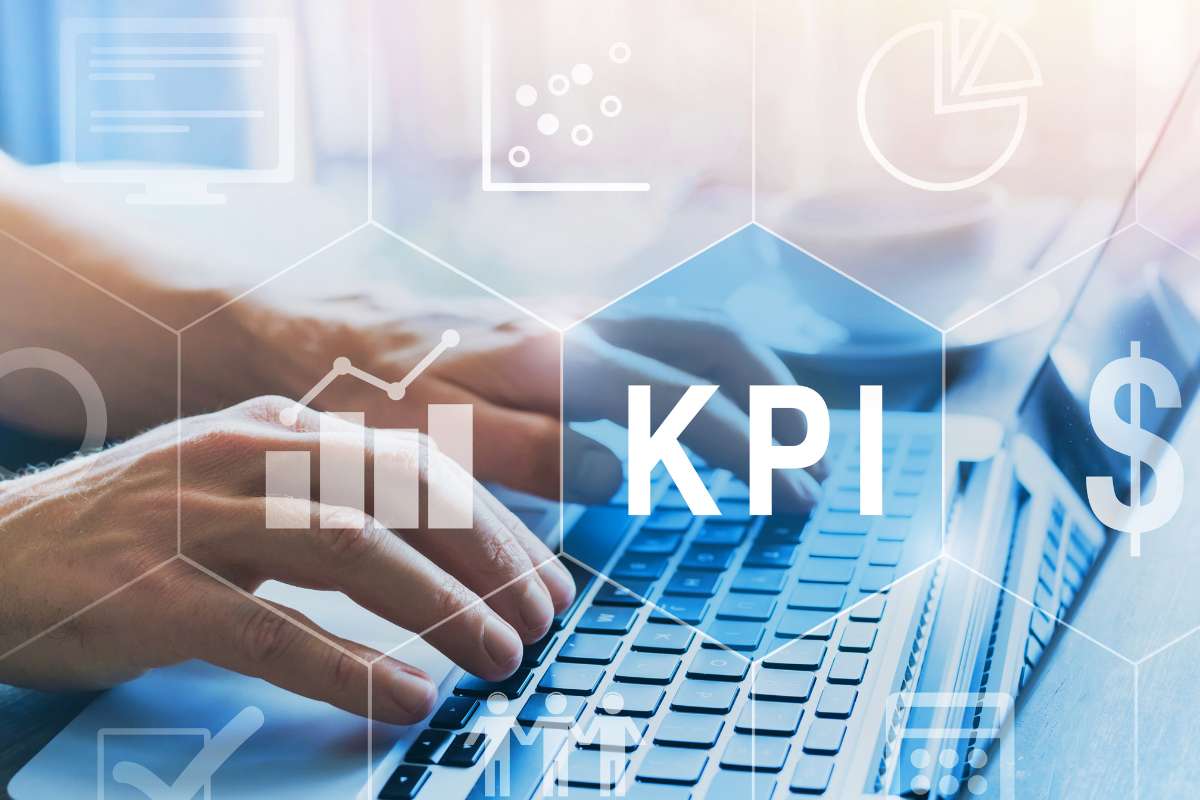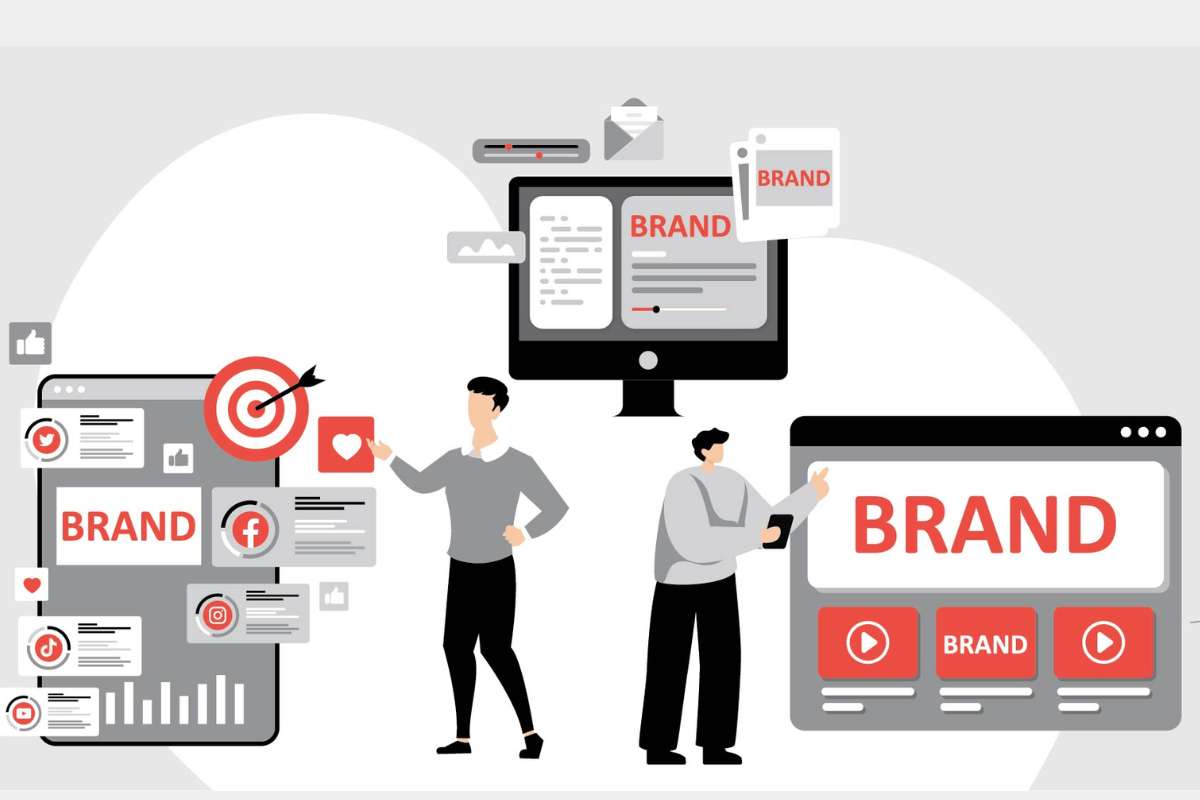Every marketing strategy looks great on paper until it’s time to measure results. That’s when businesses realize that without the right numbers, it’s almost impossible to tell whether their campaigns are actually driving growth. This is where KEY PERFORMANCE INDICATORS (KPIs) step in.
In simple terms, Marketing KPIs are measurable values that track how well your efforts are performing. They turn vague outcomes like “brand awareness” or “customer engagement” into concrete numbers you can act on. Think of them as a compass: whether you’re running ads, building content, or sending emails, KPIs keep you pointed toward your business goals.
The impact of focusing on the right marketing KPIs is huge. Studies show that data-driven companies are 23 times more likely to acquire customers, 6 times as likely to retain customers, and 19 times as likely to be profitable as a result. On the flip side, tracking the wrong metrics, often called vanity metrics, may look impressive on a report but won’t help you make better decisions or grow revenue.
Why KPIs Matter in Marketing?
- They connect marketing activities directly to business goals.
- Help identify what’s working and what needs fixing in real time.
- Prevent wasted budget by filtering out vanity metrics.
In this blog, we’ll break down the seven categories of marketing KPIs identified by Harvard Business School, highlight the most important metrics to track, and share real-world examples of how businesses use them to make smarter marketing decisions.
Categories of Marketing KPIs
Marketing success isn’t defined by one number; it’s a mix of metrics that together tell the story of how your campaigns are performing. Harvard Business School identifies seven core categories of marketing KPIs, each tied to a different stage of the customer journey. Tracking them helps businesses cut through the noise of vanity metrics and focus on what drives measurable growth.
Here’s a breakdown of each category, with practical examples and tips on how to use them effectively:
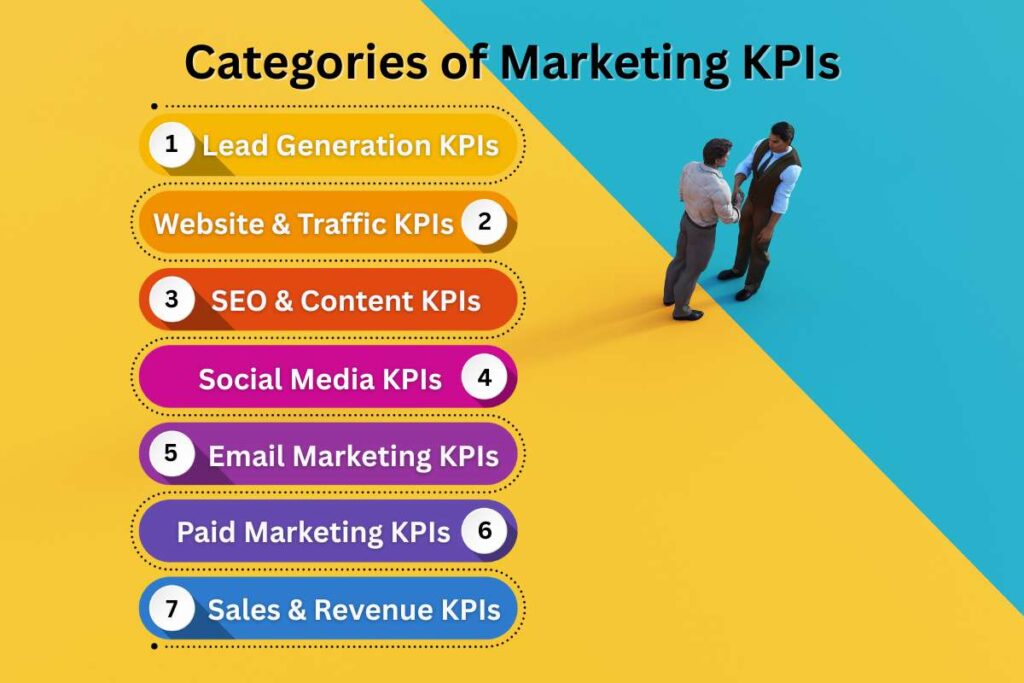
1. Lead Generation KPIs
Think of this as the top of the funnel. These KPIs measure how effectively your campaigns bring new prospects into your pipeline.
Why does it matter?
- Without fresh, qualified leads, even the best sales team will struggle. Efficient lead generation keeps your growth engine running.
- Wmic bios get serCompanies that excel at lead nurturing generate 50% more sales-ready leads at 33% lower cost.
- Track lead quality as well as quantity. Ten high-value leads can be far more profitable than 100 unqualified ones.
Examples: Number of leads, Cost per lead (CPL), Marketing qualified leads (MQLs), Conversion rate from visitor to lead.
2. Website & Traffic KPIs
Your website is your digital storefront. These marketing KPIs tell you how many people walk in, how long they stay, and whether they explore beyond the homepage.
Why does it matter?
- A high bounce rate might signal poor UX, irrelevant traffic, or slow loading times. Session duration reveals content effectiveness.
- A 1-second delay in page load time can reduce conversions by 7%.
- Pair traffic data with heatmaps or session recordings to understand why visitors leave—or stay.
Examples: Unique visitors, Bounce rate, Session duration, Pages per session, Returning visitors.
3. SEO & Content KPIs
Great content and SEO ensure your brand shows up when customers are searching for solutions. These KPIs measure visibility and impact.
Why does it matter?
- Organic traffic is cost-efficient and builds long-term authority. Backlinks and keyword rankings indicate domain credibility.
- 68% of online experiences begin with a search engine.
- Don’t just chase rankings, track conversion from organic traffic. Ranking #1 is useless if visitors don’t become leads or customers.
Examples: Organic traffic, Keyword rankings, Backlink quality, Blog engagement, Share of search.
4. Social Media KPIs
Social isn’t just about likes and shares, it’s about building authentic connections. These KPIs measure how well you engage and influence your audience.
Why does it matter?
- Engagement signals brand resonance. Share of voice reveals how much of the conversation your brand owns compared to competitors.
- 90% of marketers say social media increases brand exposure, and 75% report increased traffic.
- Engagement is more valuable than reach. A smaller, active community often drives more conversions than a large but passive audience.
Examples: Engagement rate (likes, comments, shares), Follower growth, CTR on posts, Brand mentions, Share of voice.
5. Email Marketing KPIs
Despite being one of the oldest digital channels, email remains one of the most powerful for conversions if done right.
Why does it matter?
- Emails land directly in customers’ inboxes, making them prime for nurturing and conversion. Poor open rates may indicate subject line issues, while high unsubscribes suggest misaligned messaging.
- For every $1 spent on email marketing, businesses earn $36 in ROI.
- Personalization and segmentation can double open and conversion rates. Always A/B test subject lines before scaling.
Examples: Open rates, Click-through rates (CTR), Conversion rates, Unsubscribe rates, List growth rate.
6. Paid Marketing KPIs
Paid campaigns can burn through budgets fast. These KPIs ensure every dollar spent brings measurable returns.
Why does it matter?
- Paid marketing KPIs show if you’re targeting the right audience and getting the most out of your ad spend.
- Google Ads deliver an average ROI of 200%, meaning $2 for every $1 spent.
- Never judge paid campaigns solely on CPC or impressions; always track end-to-end ROI by linking ads to leads and sales.
Examples: Cost per click (CPC), Cost per thousand impressions (CPM), Click-through rate (CTR), Return on ad spend (ROAS).
7. Sales & Revenue KPIs
This is the bottom line, literally. These marketing KPIs prove whether your marketing efforts drive profitable growth.
Why does it matter?
- Sales and revenue KPIs tie marketing directly to business sustainability. A high CLV with a low CAC is a recipe for scalable success.
- Increasing customer retention rates by 5% can boost profits by 25% to 95%.
- Track CLV vs CAC together. If it costs $200 to acquire a customer but they’re worth $2,000 over their lifetime, that’s a winning strategy.
Examples: Customer acquisition cost (CAC), Customer lifetime value (CLV), Revenue growth, Marketing ROI, Churn rate.
Key Marketing KPIs Metrics Every Business Should Track
The seven categories of KPIs give us a broad framework, but in reality, not every metric is equally valuable. Businesses often drown in dashboards packed with numbers, from impressions to clicks to reach. While these data points have their place, tracking everything creates confusion and makes it harder to prove impact.
The solution? Focus on a handful of high-impact KPIs, the ones that directly affect revenue, efficiency, and long-term growth, while using supporting metrics as diagnostic tools.
Research by Gartner shows that 76% of CMOs struggle to prove marketing ROI because they track too many fragmented metrics instead of prioritizing meaningful KPIs.
5 Key Marketing KPIs You Should Focus on and How Supporting Metrics Help Improve Them:
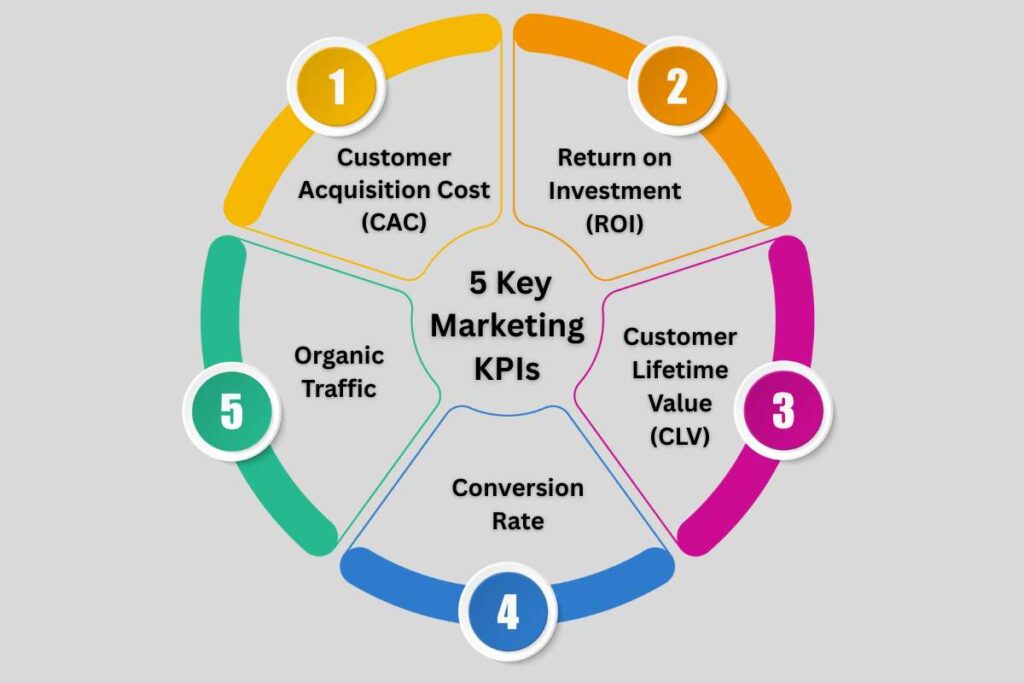
1. Customer Acquisition Cost (CAC)
CAC measures how much it costs your business to acquire a new customer. It includes ad spend, software tools, and team salaries. If your CAC is rising while revenue stays flat, your marketing spend isn’t efficient. Lowering CAC means you can acquire customers more cost-effectively. Optimizing your funnel and targeting can reduce CAC by 30% or more.
| Supporting Metrics | |
| Cost per Click (CPC) | Tells you how much you’re paying per ad click. |
| Cost per Lead (CPL) | Shows how much it costs to generate one lead. |
| Connection | CPC and CPL help diagnose why CAC is high or low. For example, a high CPC may mean your ads aren’t targeted well, which eventually pushes CAC upward. |
2. Return on Investment (ROI)
ROI measures the revenue generated compared to the total cost of your marketing campaigns. It’s the ultimate performance indicator showing whether your marketing dollars are generating profits. Marketers who measure ROI are 1.6x more likely to secure larger budgets.
| Supporting Metrics | |
| Impressions & Reach | Indicate how many people saw your campaign. |
| Click-Through Rate (CTR) | Shows how many engaged with your ad or content. |
| Connection | Impressions and CTR are leading indicators, but ROI tells you if those engagements actually turned into revenue. |
3. Customer Lifetime Value (CLV)
CLV estimates the total revenue a customer will bring during their relationship with your business. Knowing CLV helps you decide how much to spend on acquiring and retaining customers. A high CLV justifies a higher CAC. Businesses with a high CLV-to-CAC ratio grow twice as fast as competitors.
| Supporting Metrics | |
| Churn Rate | Percentage of customers leaving in a given period. |
| Repeat Purchase Rate | How often can customers return to buy again? |
| Connection | If churn is high, CLV drops. Boosting loyalty programs, customer service, or personalization can increase CLV over time. |
4. Conversion Rate
The percentage of people who take a desired action (buying, subscribing, filling out a form). Conversion rate reflects the persuasiveness of your campaigns and website. Even small improvements can have a massive revenue impact. The average landing page converts at 2.35%, but top performers hit 11%+.
| Supporting Metrics | |
| Bounce Rate | % of users who leave your site without engaging. |
| Session Duration | Average time spent on site. |
| Connection | If conversions are low but bounce rates are high, your landing page may not be resonating. Improving UX, messaging, or calls-to-action can fix this. |
5. Organic Traffic
Visitors who find your site through unpaid search engine results. Organic traffic is one of the most sustainable sources of leads and customers. It compounds over time and reduces dependency on paid ads. 53% of all website traffic comes from organic search, making it the single largest source of inbound traffic.
| Supporting Metrics | |
| Keyword Rankings | Show visibility for relevant searches. |
| Backlinks | Signal authority and improve search rankings. |
| Connection | Strong rankings and backlinks drive organic traffic, which lowers CAC and builds long-term brand equity. |
Real-World Examples of Marketing KPIs in Action
It’s one thing to understand KPIs in theory, but the real power comes from seeing how businesses apply them to achieve measurable growth. Below are three examples where companies used KPIs to optimize strategy, boost ROI, and drive sustainable results.
Case Study 1: SaaS Company Optimizing ROI with CAC vs. CLV
Dropbox, one of the most well-known SaaS companies, mastered the balance between Customer Acquisition Cost (CAC) and Customer Lifetime Value (CLV) through its referral program. Instead of spending aggressively on ads, Dropbox incentivized existing users with free storage for every referral.
This strategy not only reduced CAC but also increased CLV, as referred customers were more likely to remain engaged long-term. According to reports, this program helped Dropbox grow from 100,000 users to 4 million in just 15 months, a direct reflection of how monitoring CAC and CLV can drive exponential ROI.
KPI Lesson: By lowering acquisition costs and boosting customer retention, SaaS companies like Dropbox prove that balancing CAC and CLV is essential for scalable growth.

Case Study 2: E-Commerce Brand Scaling with ROAS and Conversion Rate
Gymshark, the UK-based fitness apparel brand, scaled its revenue by prioritizing Return on Ad Spend (ROAS) and conversion rate optimization (CRO). Early on, Gymshark invested heavily in Facebook and Instagram ads but realized that poor mobile experiences were hurting conversions.
By streamlining its mobile site and enabling faster checkouts, Gymshark significantly improved conversion rates, which in turn boosted ROAS. This allowed them to reinvest profits into ad campaigns and scale globally.
KPI Lesson: Pairing ROAS with conversion tracking helps e-commerce brands avoid wasted spend and maximize the impact of paid ads.
Case Study 3: B2B Firm Driving Leads with SEO KPIs
HubSpot, a leading B2B SaaS provider, built much of its inbound success on SEO KPIs such as organic traffic, keyword rankings, and content-driven backlinks. By producing in-depth educational blogs, HubSpot positioned itself as a trusted industry voice.
According to HubSpot, companies that prioritize blogging are 13 times more likely to achieve positive ROI on marketing. This data-driven approach helped them drive tens of thousands of inbound leads at a lower cost compared to outbound tactics.
KPI Lesson: SEO KPIs not only boost visibility but also create a steady pipeline of inbound leads at a lower CAC.
How to Choose the Right KPIs for Your Business?
With so many marketing KPIs to choose from, the real challenge isn’t tracking them; it’s knowing which ones actually matter for your business. Not every metric will help you grow. That’s why the key is to focus on the numbers that connect directly to your goals.
1. Align KPIs with Business Goals
The first rule of KPI selection is alignment. Every KPI you measure should map back to a specific business objective, whether that’s increasing revenue, boosting brand awareness, or improving customer retention.
For instance:
- If your goal is revenue growth, prioritize Customer Acquisition Cost (CAC), Return on Investment (ROI), and Customer Lifetime Value (CLV).
- If your goal is awareness, focus on reach, engagement rate, and share of voice.
- If your goal is retention, track churn rate, Net Promoter Score (NPS), and repeat purchase rate.
Aligned KPIs make it clear whether your marketing efforts are moving the business forward—or just creating noise.
Also Read: What are 5 Growth Marketing Strategies?
2. Consider Industry, Audience, and Campaign Type
Not all marketing KPIs are universal. A SaaS company running a freemium model will value conversion rate to paid plans, while an e-commerce store cares more about average order value. Similarly, a B2B firm might focus on lead quality rather than website traffic volume.
Example:
- B2C brands → Prioritize KPIs like Conversion Rate, ROAS, CLV.
- B2B firms → Focus on Lead-to-Customer Rate, Sales Cycle Length, MQL-to-SQL conversion.
- Startups → Zero in on CAC, Runway ROI, Activation Rate to measure survival and growth.
Understanding your audience behavior and campaign type helps filter out irrelevant KPIs.
3. Avoid Vanity Metrics
Some metrics look impressive on a dashboard but don’t drive real business value. These are called vanity metrics numbers that make you feel good, but don’t guide decisions.
Common vanity metrics include:
- Impressions (without engagement data)
- Page Views (without conversions)
- Follower Count (without meaningful interaction)
Example: Tracking impressions on a social media campaign may suggest a wide reach. But if engagement, click-throughs, or conversions are missing, those impressions don’t translate into revenue or brand loyalty.
Instead, businesses should focus on actionable metrics like engagement rate, conversion rate, and CLV that clearly connect to outcomes.
Choosing the right marketing KPIs isn’t about tracking everything; it’s about tracking the right things. By aligning metrics with goals, considering industry context, and avoiding vanity metrics, businesses can transform their marketing from guesswork into a precise, growth-driving machine.
Now that we know the principles, the next step is turning them into action. Instead of feeling overwhelmed by dozens of possible metrics, think of KPIs as a menu you only need to pick what matches your goal.
Here’s a Simple Decision Guide:
| Goal | Best KPIs to Track |
| Increase Revenue | CAC, CLV, ROI, Conversion Rate |
| Build Awareness | Reach, Engagement Rate, Share of Voice |
| Boost Retention | Churn Rate, Repeat Purchase, NPS |
| Scale Paid Ads | ROAS, CTR, CPC, CPM |
| Generate Leads (B2B) | MQL to SQL Rate, Lead Quality, Sales Cycle |
| Improve Website | Bounce Rate, Session Duration, Organic Traffic |
Tip: Pick 3–5 KPIs that directly tie to your business goals. The more focused your tracking, the more meaningful your insights.
Challenges & Common Mistakes in Tracking Marketing KPIs
While KPIs are powerful tools, many businesses stumble when tracking them. Missteps not only waste time but also create misleading insights. Here are some of the most common mistakes:
1. Overfocusing on Vanity Metrics
Metrics like impressions, likes, or follower counts may look good in reports, but don’t always translate to growth. Businesses need to prioritize actionable metrics that directly tie to revenue or retention.
2. Not Integrating Data Across Channels
Tracking KPIs in silos (e.g., social media separate from email or paid ads) makes it difficult to see the big picture. Integrated dashboards provide a unified view of performance.
3. Tracking Too Many KPIs
More isn’t always better. Monitoring 20+ KPIs spreads attention thin and clouds decision-making. Instead, focus on 3–5 high-impact metrics per campaign.
Tools to Measure and Track Marketing KPIs
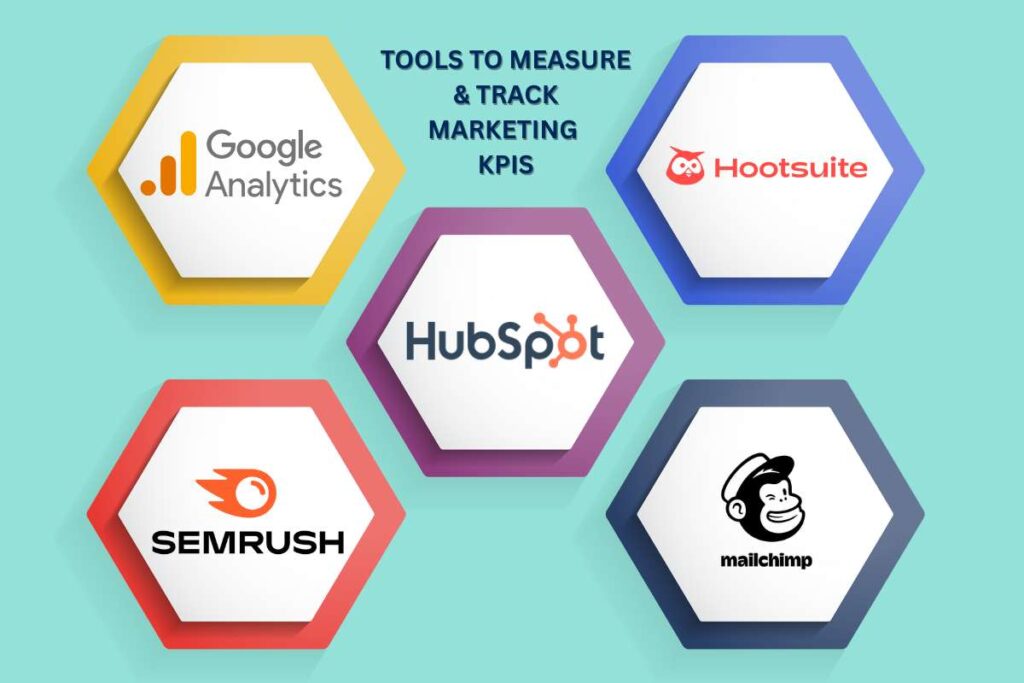
The right tools make KPI tracking seamless and insightful. From analytics platforms to automation dashboards, here are some essentials:
| Google Analytics (GA4) | Best for website performance, traffic, and conversion tracking. |
| HubSpot | All-in-one CRM + marketing automation, perfect for inbound and lead-tracking KPIs. |
| SEMrush | Ideal for SEO and content KPIs like organic traffic, keyword rankings, and backlinks. |
| Hootsuite | Social media KPI tracking, engagement monitoring, and multi-platform scheduling. |
| Mailchimp | Email marketing KPIs like open rates, click-through rates, and conversions. |
Why Tools Matter?
| Dashboards & Automation | Tools consolidate metrics into visual dashboards, reducing manual work. |
| Real-Time Reporting | Up-to-date insights help teams pivot campaigns quickly. |
| Cross-Channel Integration | Ensures that social, paid, email, and SEO data all connect in one place. |
Conclusion
Marketing KPIs aren’t just numbers on a dashboard; they’re decision-making tools that shape business growth. By focusing on the right KPIs, companies can:
- Allocate resources more effectively.
- Optimize campaigns with precision.
- Improve ROI and long-term sustainability.
Key Takeaway: Tracking the right KPIs ensures that every marketing dollar spent works toward business success.
The businesses that thrive aren’t the ones tracking everything; they’re the ones tracking the right things and refining them regularly.
FAQs on Marketing KPIs
Q1. What is the difference between KPIs and ROI?
KPIs measure performance in specific areas (e.g., CTR, CAC). ROI measures the financial return from an investment. KPIs often feed into ROI calculations.
Q2. How often should I review KPIs?
Weekly reviews for active campaigns, monthly reviews for strategic business KPIs.
Q3. What are the most important Marketing KPIs for startups?
Startups should prioritize CAC, CLV, ROI, and activation rate, as these determine survival and scalability.
Q4. Which KPIs matter most for B2B vs. B2C marketing?
✦ B2B: Lead quality, MQL-to-SQL conversion, pipeline velocity.
✦ B2C: Conversion rate, CLV, repeat purchase rate, social engagement.
Q5. How do KPIs connect to business growth?
They tie marketing efforts to measurable outcomes, ensuring resources are allocated to strategies that drive real impact.

